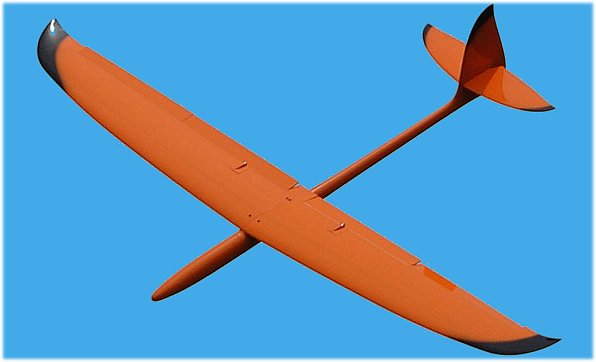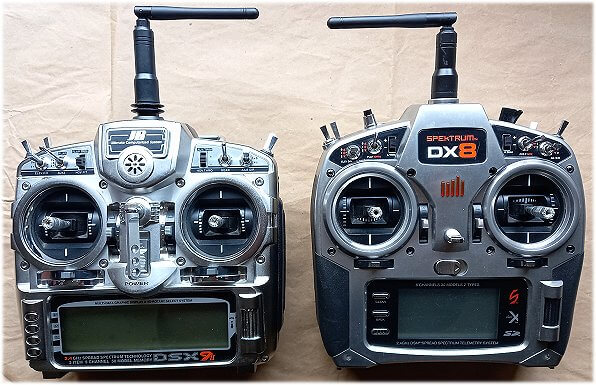RC Glider Wing Setups
- Full House Glider Wings Explained
Learning about 'full house' rc glider wing setups might not be high on your agenda if you've only just entered the radio control gliding hobby, but there will probably come a time when you want to fly a more advanced glider and so will need to know about the wing function options available to you.
I've been flying rc gliders for many years, in fact slope soaring is my preferred sector of radio control flying. And as a "glider guider" I've come to learn about full house wing setups and how each function effects your glider's flight characteristics.
So the aim of this article is to introduce you to these different functions, and hopefully when the time comes you will have a good understanding of what each wing function does and how you can use them to your benefit.

Above: my Luna 2 mouldie features 'full house' wing setups.
RC Glider Wing Functions - Why Bother?
To state the obvious, non-powered rc gliders rely solely on different types of air movement and lift to keep airborne. By using the flaps and ailerons in various ways it is possible to dynamically change the way the wing generates lift, and thus the glider's flight performance can be changed.
As a result, a good rc glider wing setup can drastically improve flight performance and this is especially important in competition gliding.
Whether extra speed is needed through a turn, or extra lift required while hunting thermals, having a well set up wing will help you get much more out of your glider.
Aileron & Flap Wing Functions
The beauty of today's modern computer radios is that all manner of programmable mixing is possible, and many radios have glider-specific mixes and programmes.
With such a radio and the crucial 4-servo wing setup, it should be possible to achieve the following aileron and flap functions:
Camber
When activated the flaps and ailerons all drop down a few millimeters, all together and by the same amount. The result of dropping the entire trailing edge of the wing slightly is to increase lift without noticeably increasing drag.
Camber is used, for example, when a thermal has been found and you want to squeeze as much lift generation out of your glider wing as possible.

Above: Camber drops the trailing edge of the wing slightly.
Reflex
Reflex is the opposite to camber and when activated the flaps and ailerons all move upwards slightly, in unison. Changing the airfoil in this way results in the glider becoming more 'slippery' through the air, hence you get a slight increase in speed. The penalty here is slightly reduced lift, so you wouldn't want to use a reflexed wing to circle in thermals.
Reflex can also be brought in to use for inverted flight, to create additional lift (essentially inverted camber).

Above: Reflex slightly raises the trailing edge of the wing.
How you operate camber and reflex on the transmitter will be down to the type of switches/sliders available to you, and your own personal preference.
On my JR DSX9 transmitter I have this control mixed to a side slider, operated with my index finger.
Crow braking
Also called 'Butterfly braking', this rc glider wing function is used when landing.
When Crow is activated both flaps drop down and both ailerons deflect upwards, all at the same time. This gives a very effective combination of drag from the flaps and reduced lift from the up ailerons, now acting as spoilers. The result is that a fast-flying glider can be slowed right down and, when landed well, can be brought in with very little forward airspeed.
It's common for crow braking to be operated by the throttle stick of the Tx, although having it on a switch or slider is perfectly acceptable.
It's usually necessary to mix some degree of down-elevator compensation with crow braking. A glider will likely pitch upwards, sometimes drastically, when crow is activated because of the sudden increase in lift caused by the deflected flaps.
Having the elevators deflect downwards automatically is very helpful, and gives you one less thing to think about.

Above: Crow, or butterfly, braking raises the ailerons and lowers the flaps.
Full-span ailerons
Here the flaps are mixed to operate with the ailerons in such a way that each flap moves in conjunction with its neighbouring aileron, effectively turning the whole trailing edge of the wing in to one long aileron, thus greatly increasing roll response.
It's a good idea to set the flap deflection (throw) to less than that of the aileron; by doing so you are reducing the amount of drag caused by the flap. Having the flap deflect to about 2/3 the aileron deflection is a good starting point, and then tweak as necessary.
If mixing full-span ailerons, it's a good idea to have them switchable on/off for different flight modes. For example, I always deactivate them (i.e. return to normal ailerons only) when landing so that the crow braking flap deflection is not upset by aileron input.

Above: Full span ailerons have the flaps and ailerons working in unison.
Snap flaps
In competition gliding a race can be won or lost in the turns.
Snap flaps are used to tighten the turning capability of the glider and are achieved by mixing the flaps with the elevators.
When up-elevator is applied (perhaps a preset amount of deflection) the flaps deflect downwards slightly and the glider performs a more aggressive turn as a result.
Mixing Madness
As previously mentioned, modern computer radios (excluding the basic ones) are capable of doing many things - perhaps too much??
The secret to a good rc glider wing setup is in your radio's mixing capability, and indeed in your capability of knowing how to use the mixing functions!
The earlier Spektrum DX8 radios, for example, do not have glider-specific programming although there is an official software download intended for full house glider wing setups, that makes use of the programmable mixing (P-mixing) functions of the radio. The later DX8 versions do have glider-specific programming options, although you might need to download them from the Spektrum Community website.
From my own personal experience this download is a basic starting point only, and in truth I ended up moving from my DX8 (which, incidentally, is an excellent radio for planes and helis) to a JR DSX9 which does have dedicated glider programming - sooo much easier!

Above: my JR DSX9, left, is more glider-friendly than my DX8.
If you're having trouble with working out how to mix flaps and ailerons, the best thing to do is get on to an internet forum and ask for help. It isn't an easy thing to do if you have no experience with it and your radio isn't a glider-friendly one. I can say that from experience!
So those are your basic rc glider wing setup options available to you. Needless to say there are other mixes out there but those listed above are the ones that you're most likely to come up against if you choose to fly a more advanced rc glider.
It's well worth taking the time to set up advanced wing functions if you can, they really do make a difference to a glider's performance in the air.
